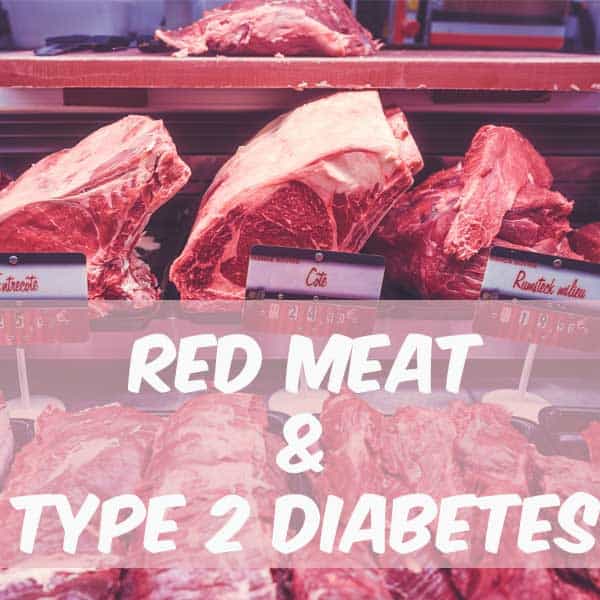We’ve always been told to make sure you eat your meat, especially red meat as it is chalk full of important vitamins and nutrients such as iron, B12, zinc and protein. But red meat is also full of other things that might not be as beneficial to us.
You may be aware that too much red meat is high in saturated fat, which in turn raises your cholesterol. Higher levels of bad cholesterol (LDL) are associated with a higher risk of developing heart disease. But it was found during many research studies that a higher consumption of red meat can also lead to an increased risk of developing type 2 diabetes.
Across the world, type 2 diabetes is reaching epidemic levels, affecting almost 400 million from all over. In the United States, more than 21 million people have been diagnosed with another 8.1 million undiagnosed or unaware that they have type 2, as estimated by the CDC.
The Data Doesn’t Lie
Recent studies conducted by researchers at the Harvard School of Public Health have determined a link between consuming red meat in excess and the increase in incidences of Type 2 diabetes.
The study found that those who are eating more red met, roughly 3 ½ servings or more each week, had an increased risk of developing type 2 diabetes by 50% within the next four years.
When you think about an increase by 50% this is substantial. The study’s co-author, Frank Hu, who is a professor of epidemiology and nutrition at the Harvard School of Public Health stated this was “a really large and significant increase”.
While these results are quite alarming, researchers did find that those who decreased their consumption of red meat, lowered this risk by 14% during their 10-year follow-up. Let’s take a deeper look into what this study truly has revealed.
I advise reading the following:
What is Red Meat?
Before you get too worried about what you are eating currently in your diet, let’s take a look at what red meat is considered to be exactly. Red meat includes veal, pork, mutton, goat, lamb and beef. The USDA defines red meat as all meat which is obtained from animals because they contain much higher levels of myoglobin than fish or the white meat from chicken. While poultry is considered to be white meat, goose and duck are considered to be red meat.
You may be wondering why ‘pork’ is included in the red meat list. Under the culinary definition of red meat, pork is considered to be white meat, but with a myoglobin level of 0.10 to 0.30 %, the USDA considers pork to be red.
But Doesn’t Red Meat Offer Nutritional Sources?
Yes, this is true. Red meat offers larger amounts of iron, zinc, phosphorus, creatine, vitamin B12, riboflavin, niacin and thiamin. While there are some important nutritional sources provided by red meats, the USDA still recommends a limited consumption of red meat. They have been adamant about eating more seafood, and other high protein foods.
Unprocessed and Processed Meats
The study did reveal that eating unprocessed meats lead to a 19% higher risk of developing type 2 diabetes. Unprocessed meat was defined has any meat from pork, lamb or beef which wasn’t preserved by curing, salting, smoking or adding chemical preservatives to it. Processed meat examples include salami, hot dogs, sausages and various lunch meats. The health risks of the overabundance of processed meats aside from the development of type 2 diabetes are actually very alarming.
Omega3 and Omega 6 Ratio’s
The majority of processed meats have a large tendency to throw off the body’s balance of Omega 6 and Omega 3 ratios. This is due to processed meats being fed from corn and soy products. Corn contains extra Omega 6 oils, which can increase the amount consumed when processed meats are eaten. A good balance between omega 3s to omega 6s is vital to ensuring the reduced risk of cardiovascular diseases, depression, diabetes and Alzheimer’s.
A proper ratio of omega 6 oils to omega 3’s is 1, but the average Western diet ratio is between 20:1 to 50:1. This is due to the consummation of processed and fried foods. While most meats even those that are grass fed contain omega 6’s, those that are processed contain much higher levels of HNE, Hydroxynonenal toxins. These toxins can be absorbed into the body’s tissues and cells to cause inflammation throughout.
Gut Bacteria Together with Processed Meats Can Decrease Insulin Sensitivity
The bacteria in your gut is important in helping to maintain your overall health. This is due to its job to protect the intestinal barrier which works to keep toxins out of your bloodstream. When you have bad gut bacteria it will create new toxins from processed meats that are consumed. Poorer quality processed meat typically is full of antibiotics that are also harmful to your gut flora. Studies have proven that antibiotics can cause a rapid shift of the composition of your gut flora which is difficult to recover without dietary measures.
Processed meats contain sometimes upwards of 50% more nitrates than unprocessed meats. Nitrates are a problem for those who have ad gut bacteria. When you have an imbalance in your gut flora, nitrates can decrease the release of insulin in the body, as well as your glucose tolerance. Together this creates the perfect storm to increase your risk of developing type 2 diabetes.
Are Processed Red Meats Carcinogenic to Us?
In 2015, the IARC, or International Agency for Research on Cancer, released a report about processed red meats, stating they were ‘carcinogenic to humans’. Processed meats such as hot dogs, sausage, beef jerky, canned meat and ham are considered to be sources of red meat that you should most definitely limit in your daily diet.
Other Health Concerns
While developing type 2 diabetes is a huge concern, there are many other health risks associated with an overconsumption of red meat.
- Cancer
Many studies have shown that consuming red meat and processed meats increases your cancer risk. Some advocates have stated that these risks are difficult to determine as this really depends on how the meat is prepared. Cooking meat at higher temperatures such as grilling, barbecuing, frying or broiling can form what is known as HCAs or Heterocyclic amines, also known to many as carcinogenic substances. Processed meats are usually much higher in sodium which is associated with a higher risk of developing stomach, colon, throat, mouth and esophageal cancers.
- Heart Disease
There have been multiple studies over the years linking an increased risk of developing heart disease and consuming red meat. The latest has found that when you consume red meat, there is a reaction by the microbes within your gut. These reactions are triggered by what is known as carnitine, a nutrient in red meat. The study has found that these particular reactions are contributors in developing heart disease. This only adds to the growing data which reinforces there is a connection between the consumption of red meat, and the development of heart disease.
Previous studies have added to this growing data and reinforced the connection between the carnitine in red meat and heart disease. The results of these studies is helping doctors better understand more about the link between heart disease and the consumption of red meat. This greatly helps in the development of better tools and medications in the treatment of heart disease.
How to Lower Your Red Meat Consumption
Trying to reduce your consumption of red meat can be difficult at first, especially when your used to having it. As with anything else, when you have to make changes, slow and steady win the race! Here are some tips to help you gradually reduce your red meat consumption.
- Try adding one “Meat Free” day to your diet weekly. At a reduction of 15% of red meat consumption this can greatly benefit your health.
- Include other protein sources to ensure you are getting an adequate amount of protein. Foods like almonds, and lentils can help keep you feeling fuller and more satisfied throughout the day.
- Bulk up your meaty meals by including grains, vegetables and beans.
- Try natural, non-processed snacks like carrots with hummus, and apples and peanut butter to help keep you full and provide great nutrition.
- Try making your favorite foods meat free by using vegetables and other foods in replace of the meat.
- Eliminate all processed meats from your diet.
- Cut your meat serving size in half. This is a great way to slowly reduce your red meat consumption.
- Stop making your meat the star attraction on your dish, instead build up your meals with the focus being on the vegetables.
Further reading:
Conclusion
With all the information on red meat out there, it can become rather confusing. However, slowly reducing your consumption of red and processed meats can not only help you to feel better, but decrease your risk of type 2 diabetes. Before starting any new diet, it’s recommended that you always consult your doctor to gather their input on what you should do. We know meat is tasty but always stay within your diet's limit.
TheDiabetesCouncil Article | Reviewed by Dr. Sergii Vasyliuk MD on June 01, 2020





